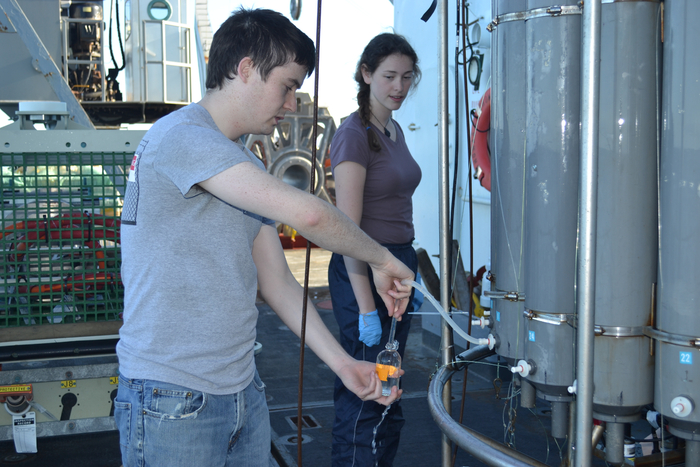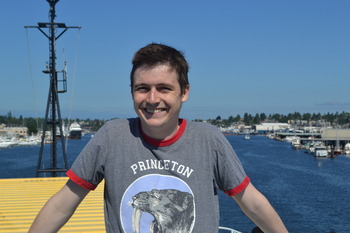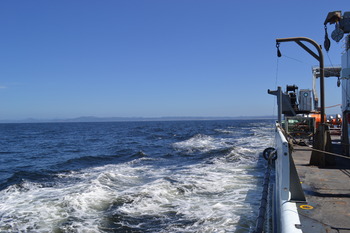July 13, 2013
1:00 PM - Deb Kelley asked my advisor Danny and me if we would mind processing the first data files collected from seafloor instruments deployed as part of the RSN project. She wants to see what they look like, and share them with a hungry public as quickly as possible, but all of the engineers are busy prepping for the next dive. We agree. She askes Danny how long he thinks it will take. He answers nonchalantly that it shouldn't take more than an hour or two. I have an interview at 3 PM about an intstrument we have been prototyping.
1:05 PM - We get the files from James Tilley, one of the engineers who joined us this leg. The beguiling curves of his USB drive hide the challenge of a lifetime, or at least an afternoon. Danny opens the descriptively named 10.7.2.12_20130712_193334_putty.log, and a neat array of decimal numbers winks back at us. Sure, it's interleaved with a bunch of system calls, and there seem to be three alternating data streams, but nothing a little cutting and pasting can't solve. We turn our attention to 10.7.2.12_20130712_193334_putty.log's spicy cousin, 10.7.2.6_20130712_192816_putty.log. "What is this .xml?" Danny mutters as we both contemplate our apreciation for good file naming conventions. Opening it in a web browser doesn't help. Because the data we are after is jumbled up with text and system alerts, it is clear we are going to need to make a parser, which I volunteer to write. She had me at _192816_.
1:05:01 PM - I decide that the parser is going to be a DFA and that I'm going to write in C. Because.
1:40 PM - After clearing away some headerlines and alerts that appear to only occur once, I have the logic of the parser sketched out on paper. I run over an example by hand, and am satisified that it should work. I power up emacs from the command line. GUI? I don't need no stinking GUI.
1:41 PM - I remember that I have some old DFA code written in C on my laptop, so of course I pull that up as a template. I may purposely be using emacs and C, but I'm not dumb enough to do so without some working code in front of me. Some M&M's from the mess and the opening bars of Radiohead's "Everything In Its Right Place" complete the ambience of my makeshift code lair.
2:20 PM - About halfway through the first draft, I promise Danny working code in 30-60 minutes. My typing speeds up.
2:57 PM - Closing in on my interview with Adrian, I ask her for ten more minutes so I can finish the first draft.
3:07 PM - On the dot, I close the last curly bracket and save my work. I compile hopefully, thinking maybe this will be the time that I didn't make one mistake. It is not to be. I throw on a sweater to hide my American Museum of Natural History t-shirt from the camera; I love it, but the T-Rex on the front makes me look younger than I already do.
3:15 PM - Adrian wraps up our brief interview, and I make it back to my keyboard. A handful of repaired typos later it is working on my test case, and I run it on the full file. Success! Danny nods appreciatively at my punctuality, though he is facing away from me, and wearing headphones, so I may be reading too much into it.
3:25 PM - I tear through a quick R plotting script, and I have graphs. Data from the seafloor!
3:30 PM - Deb is happy we can share our first data with the public, John points out that the pressure sensor reading seems to line up with the semidiurnal tide. I imagine that we high five. It is awesome.
3:45 PM - I hand off my code and a brief readme to Jesse Dosher, an RSN engineer and coder. Maybe it will be useful to someone down the line.
3:46 PM - I take off my coding hat, and go back to being a student scientist. Though borne of necessity, my brief sojourn back into the realm of computer science has been fun. I'm sure I'll be back.
Until next time...
July 9, 2013
When friends and family hear that I’m going to sea, they understandably want to hear about the science, why we’re going and what we hope to accomplish. I’m glad to tell them of course, but those are never the things that I really want to talk about. It’s the minutia of everyday life, and the experience of life on a research vessel that I am secretly wishing on them when I say, “I wish you could see what it’s like.” The roller coaster feeling of walking on a rolling ship, the sound of waves slapping the hull at night, the mix of delirium and intense focus that comes with the constant cycle of naps and work at all hours. Of course, you have to be a bit strange to like that sort of thing, and I suppose that’s why we’re here.
If you’ve never spent much time on a research vessel, there’s a few things you should know. The first is that the ship, her crew, and the scientists aboard operate 24 hours a day. Because or this, we are separated into watches, and as a result people are sleeping at all hours as well. However, because meals still follow a normal schedule, the night watch can get pretty long (and hungry). Luckily there’s always coffee and snacks available (making it very easy to put on an extra layer of insulation). Because everyone’s always interested in seeing what’s going on, most people adopt a strategy of nap when you can, sleep when you’re getting stupid.
The second thing you should know about life on board a ship is that the ground beneath you is always moving as the ship rolls with the waves. Now this might be obvious, but there are many consequences for daily life. Everything has to be tied down or latched, and nothing can be allowed to roll freely. Some solutions can be improvised (wrapping a can of shaving cream in some spare underwear to muffle the sound, jamming the wheels of your office chair with duct tape) while others need to be more carefully planned (tying down computer monitors and lab equipment). One has to always be careful when pouring juice in the mess as both the cup and the juice can move. Showers can be treacherous. The most interesting effects though have to do with how your body adjusts to what is from your perspective a constantly varying gravity. Because walking is essentially the art of continuously falling forward, you find that your pace naturally slows down on the upward roll, and rapidly accelerates on the downward. This can be particularly noticeable on the stairs, where one alternates between near weightlessness and a sumo stairmaster. Days after returning to dry land, those who have been at can suffer from “dock rock”, finding themselves waiting for the roll to close a door or drawer that they are comically holding ajar.
The last thing you should know, is that lots of our preconceptions about living at sea are wrong. Ships don’t steer using a big wheel (I only found this out recently), the ocean doesn’t smell like much (that smell at the beach is the shore), and you’ll be hard-pressed to find many people with talking parrots. What you do find though, are lots of people pulling together, working as hard as they can to try to accomplish something bigger than themselves. One preconception is right; going to sea is an adventure.




